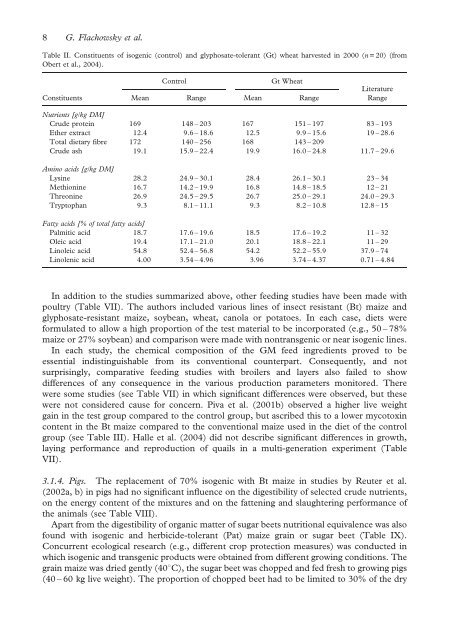Animal nutrition with feeds from genetically modified plants - Cib
Animal nutrition with feeds from genetically modified plants - Cib
Animal nutrition with feeds from genetically modified plants - Cib
Create successful ePaper yourself
Turn your PDF publications into a flip-book with our unique Google optimized e-Paper software.
8 G. Flachowsky et al.<br />
Table II. Constituents of isogenic (control) and glyphosate-tolerant (Gt) wheat harvested in 2000 (n = 20) (<strong>from</strong><br />
Obert et al., 2004).<br />
Control Gt Wheat<br />
Constituents Mean Range Mean Range<br />
Literature<br />
Range<br />
Nutrients [g/kg DM]<br />
Crude protein 169 148 – 203 167 151 – 197 83 – 193<br />
Ether extract 12.4 9.6 – 18.6 12.5 9.9 – 15.6 19 – 28.6<br />
Total dietary fibre 172 140 – 256 168 143 – 209<br />
Crude ash 19.1 15.9 – 22.4 19.9 16.0 – 24.8 11.7 – 29.6<br />
Amino acids [g/kg DM]<br />
Lysine 28.2 24.9 – 30.1 28.4 26.1 – 30.1 23 – 34<br />
Methionine 16.7 14.2 – 19.9 16.8 14.8 – 18.5 12 – 21<br />
Threonine 26.9 24.5 – 29.5 26.7 25.0 – 29.1 24.0 – 29.3<br />
Tryptophan 9.3 8.1 – 11.1 9.3 8.2 – 10.8 12.8 – 15<br />
Fatty acids [% of total fatty acids]<br />
Palmitic acid 18.7 17.6 – 19.6 18.5 17.6 – 19.2 11 – 32<br />
Oleic acid 19.4 17.1 – 21.0 20.1 18.8 – 22.1 11 – 29<br />
Linoleic acid 54.8 52.4 – 56.8 54.2 52.2 – 55.9 37.9 – 74<br />
Linolenic acid 4.00 3.54 – 4.96 3.96 3.74 – 4.37 0.71 – 4.84<br />
In addition to the studies summarized above, other feeding studies have been made <strong>with</strong><br />
poultry (Table VII). The authors included various lines of insect resistant (Bt) maize and<br />
glyphosate-resistant maize, soybean, wheat, canola or potatoes. In each case, diets were<br />
formulated to allow a high proportion of the test material to be incorporated (e.g., 50 – 78%<br />
maize or 27% soybean) and comparison were made <strong>with</strong> nontransgenic or near isogenic lines.<br />
In each study, the chemical composition of the GM feed ingredients proved to be<br />
essential indistinguishable <strong>from</strong> its conventional counterpart. Consequently, and not<br />
surprisingly, comparative feeding studies <strong>with</strong> broilers and layers also failed to show<br />
differences of any consequence in the various production parameters monitored. There<br />
were some studies (see Table VII) in which significant differences were observed, but these<br />
were not considered cause for concern. Piva et al. (2001b) observed a higher live weight<br />
gain in the test group compared to the control group, but ascribed this to a lower mycotoxin<br />
content in the Bt maize compared to the conventional maize used in the diet of the control<br />
group (see Table III). Halle et al. (2004) did not describe significant differences in growth,<br />
laying performance and reproduction of quails in a multi-generation experiment (Table<br />
VII).<br />
3.1.4. Pigs. The replacement of 70% isogenic <strong>with</strong> Bt maize in studies by Reuter et al.<br />
(2002a, b) in pigs had no significant influence on the digestibility of selected crude nutrients,<br />
on the energy content of the mixtures and on the fattening and slaughtering performance of<br />
the animals (see Table VIII).<br />
Apart <strong>from</strong> the digestibility of organic matter of sugar beets <strong>nutrition</strong>al equivalence was also<br />
found <strong>with</strong> isogenic and herbicide-tolerant (Pat) maize grain or sugar beet (Table IX).<br />
Concurrent ecological research (e.g., different crop protection measures) was conducted in<br />
which isogenic and transgenic products were obtained <strong>from</strong> different growing conditions. The<br />
grain maize was dried gently (408C), the sugar beet was chopped and fed fresh to growing pigs<br />
(40 – 60 kg live weight). The proportion of chopped beet had to be limited to 30% of the dry


